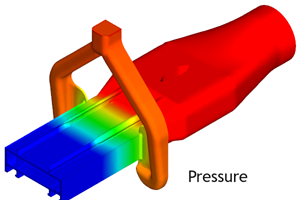Building a Business on Energy Savings
Entrepreneur Sven Eckert doesn’t like to waste energy.
Entrepreneur Sven Eckert doesn’t like to waste energy. When he started a plastics fabrication ┤¾¤¾┤½├¢, Empur Produktions GmbH in Buchholz-Mendt, Germany, the regional power authority wanted to charge him the equivalent of more than $100,000 to bring electricity to the new plant. Eckert, a mechanical engineer, instead put two large diesel generators into his plant. By generating his own power and process heat, he ended up getting an energy rebate from the power authority. More recently, Eckert’s taste for energy savings led him to risk being the first to try out a novel type of extruder drive that’s frugal with electricity.
Empur was set up in 1997 as a subsidiary of his father’s pipe extrusion ┤¾¤¾┤½├¢ to supply film and foam fabrications for in-floor heating systems. When Eckert’s father sold the pipe extrusion ┤¾¤¾┤½├¢ to Uponor of Finland in ’99, Empur was on its own.
The next year Empur expanded into extruding hot-water tubing and making brass fittings, allowing it to sell complete in-floor heating systems and other plumbing components to distributors. Eckert bought a small primary extruder and two extrusion coaters to make polyethylene tubing—radiation crosslinked for hot-water piping and non-crosslinked PE for in-floor heating (85 to 90 F). Both types of tubing are coated off-line with a tie layer and EVA.
The in-floor heating ┤¾¤¾┤½├¢ grew faster. Eckert wanted to expand his tubing production but was limited by the extruder capacity. So when Reifenhauser GmbH in Troisdorf, Germany, approached him last March with an offer to try out an experimental extruder motor with no gearbox, Eckert accepted. Use of the motor would be free, but the special attraction was the prospect of using up to 10% less energy than a conventional extruder with a gearbox.
Reifenhauser wanted a beta site for its new extruder motor within 45 minutes of its own plant. It wanted one that would run the new motor hard—non-stop at least six days a week. Reifenhauser had only three months to gather heavy-duty production data on the new motor technology before introducing it globally at NPE 2003 in Chicago last June. Eckert accepted the offer, risking his entire production on one line with the new extruder motor. The first commercial REItorque motor in the world was installed at Empur on a Saturday in early May. It ran in production on the following Monday and has kept going ever since, Eckert says.
The sound of silence
Reifenhauser had worked for three years with Siemens AG to adapt Siemens’ gearless direct-drive motor to powering extruders. The gearless motor is shaped like a hollow cylinder or donut with the extruder screw passing through the middle into a thrust bearing (see PT, Aug. ’03, p. 74). The rotor contains a permanent magnet and turns with low resistance inside the stator, which houses the electrical windings (the reverse of a standard DC motor). The motor generates up to 11,000 Nm of torque at relatively low speeds of 20 to 300 rpm.
Eckert’s extruder has a 60 mm diam. and 33:1 L/D. It originally came with a 60-kw motor and maximum output of 242 lb/hr. When that motor was replaced with the 100-kw REItorque motor, the same extruder produced 506 lb/hr. Cooling tanks were lengthened as far as the room would allow, but not enough to utilize the extruder motor’s full capacity. So Empur is able to use only 90 kw.
When the gearless motor was first installed, Eckert recalls walking onto the production floor and thinking the line had broken down. The foreman assured him it was working fine. “It’s absolutely silent except for a thin sound like crickets when you’re close to it,” Eckert says. “There is no vibration, no fluctuation in rpm, no pulsing. Speed fluctuation is just 0.1 rpm, whereas with the original motor it was 1.1 rpm, or 10 times higher.”
Eckert has already ordered a second extruder with the direct-drive motor, which he hopes to have running by the end of the year, along with new storage silos, higher volume feeders, and longer cooling tanks. And all this will run on his original two generators.
Related Content
Corrugated Tube Crossheads
Multiport spiral-flow design is said to provide a balanced compound distribution with no weld lines to the corrugator.
Read MoreUpdated Software Reduces Die Design Iterations
New software said to reduce the number of fine-tuning iterations and die development time by at least 50%.
Read MoreTight-Tolerance Molder Dips Toe in Extrusion Waters
Midwest Precision Molding brings extrusion capacity in-house to assist a customer that was having a sourcing issue with its existing overseas suppliers.
Read MorePart 2 Medical Tubing: Use Simulation to Troubleshoot, Optimize Processing & Dies
Simulation can determine whether a die has regions of low shear rate and shear stress on the metal surface where the polymer would ultimately degrade, and can help processors design dies better suited for their projects.
Read MoreRead Next
For PLASTICS' CEO Seaholm, NPE to Shine Light on Sustainability Successes
With advocacy, communication and sustainability as three main pillars, Seaholm leads a trade association to NPE that ‘is more active today than we have ever been.’
Read MoreSee Recyclers Close the Loop on Trade Show Production Scrap at NPE2024
A collaboration between show organizer PLASTICS, recycler CPR and size reduction experts WEIMA and Conair recovered and recycled all production scrap at NPE2024.
Read More










